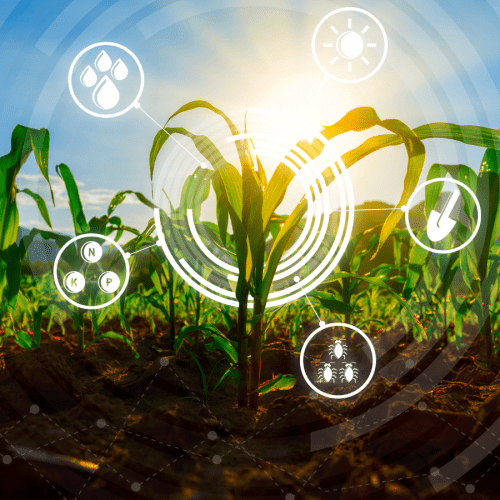A Modern Farmer

Farming is a constantly evolving practice, and technology within the industry has always been an integral part of a farmer’s success. The technology available to farmers today has allowed us to reach yields that would have been unimaginable even less than 80 years ago. This in turn has also created a system in which agriculture is focused primarily on efficiency and perfecting all components of the field from utilizing the microbials in the soil to implementing aerial imagery.
From this increased focus on sustainability, product maximization, and loss prevention, innovators have taken the opportunity to capitalize and create new technology to push agriculture even further ahead. Drones, autonomous vehicles, sensors (both soil and above canopy), biologicals, and weather stations are becoming the new face of that little red barn, white fence picture perfect farm. AgVance, Arable, and EarthSense are just a few of the companies that have decided to take part in revolutionizing the future of agriculture, all with the common goal of producing more with less.
Ceres Imaging was started in 2014 by Ashwin Madgavkar, a graduate student with the ambition to help the California growers operating within the means of a severe drought. Ceres still has an overarching goal of enabling farmers to apply the data from their high-resolution aerial imagery and advanced analytics to identify issues within their fields and quickly fix them. Their aerial data is the first of its kind to evaluate crop heath as precise as each singular plant. But also, still give the farmer a complete view of their field with layering options such as NDVI, RGB, and infrared to analyze and measure changes in crop health and uniformity. Aerial imagery such as this, is offering farmers the ability to reduce time and cost in traveling to fields to “manually” scout, as well as, providing instantaneous knowledge about each and every field, with fast reaction time to help application to be more precise and to correct possible issues.
Arable was founded by Adam Wolf, Ben Seigfried, and Kelly Caylor in 2014 with hopes to provide integrated data on climate and crop health in order to support farmers in the caring and managing of their fields. The Arable Mark 2 is able to use thermal, acoustic, and auxiliary sensors, along with probes, pressure switches, and wind speed monitors to measure and collect data on around 40 different elements like precipitation, chlorophyll index, growing degree days, soil moisture, and solar radiation. This above canopy sensor has a cloud-based platform in which all of the data collected is sent to an app that can be housed on the farmer’s phone. Above canopy sensors such as this, can be seen as one of the forefront of sustainability movement as they transform farming into a precise and data-driven industry, increasing profits and benefiting the environment.
EarthSense was founded at the University of Illinois’ Research Park in 2016 by Chinmay Soman and Girish Chowdhary. EarthSense creates autonomous robots (TerraSentia) that have evolved and continued to evolve as they expand their products role in the field. The robot began as an under-canopy data collector that is able to fit in between the rows of crops so that farmers can have a different view of their fields other than what drones and satellite imagery can give them. While on their assignment, the small yet ruggedized robot collects data such as corn ear height, stand counts, soybean pod count, stem width, plant height, and lead area index. Now EarthSense has extended its reach into under canopy cover crop seeding. The autonomous robot is able to broadcast the cover crop seed in June and July when the cash crop is still standing at $5 per acre, rather than the current average cost of $15 per acre. EarthSense plans to continue to expand to create bigger robots, robots that can pull weeds, among a number of sustainable practices to contribute to carbon sequestration operations and reduce input costs.
Integrating technology such as these on the farm is truly what will redefine agriculture’s ability to produce food more efficiently than ever before. Organizations such as Precision Conservation Management enable farmers to see how beneficial integrating sustainable practices that arise from these technologies into their operation truly is. We are in the age of producing more with less, and with these improved technologies and new farming practices our farmers are in a good position to more than accomplish this.











































































































